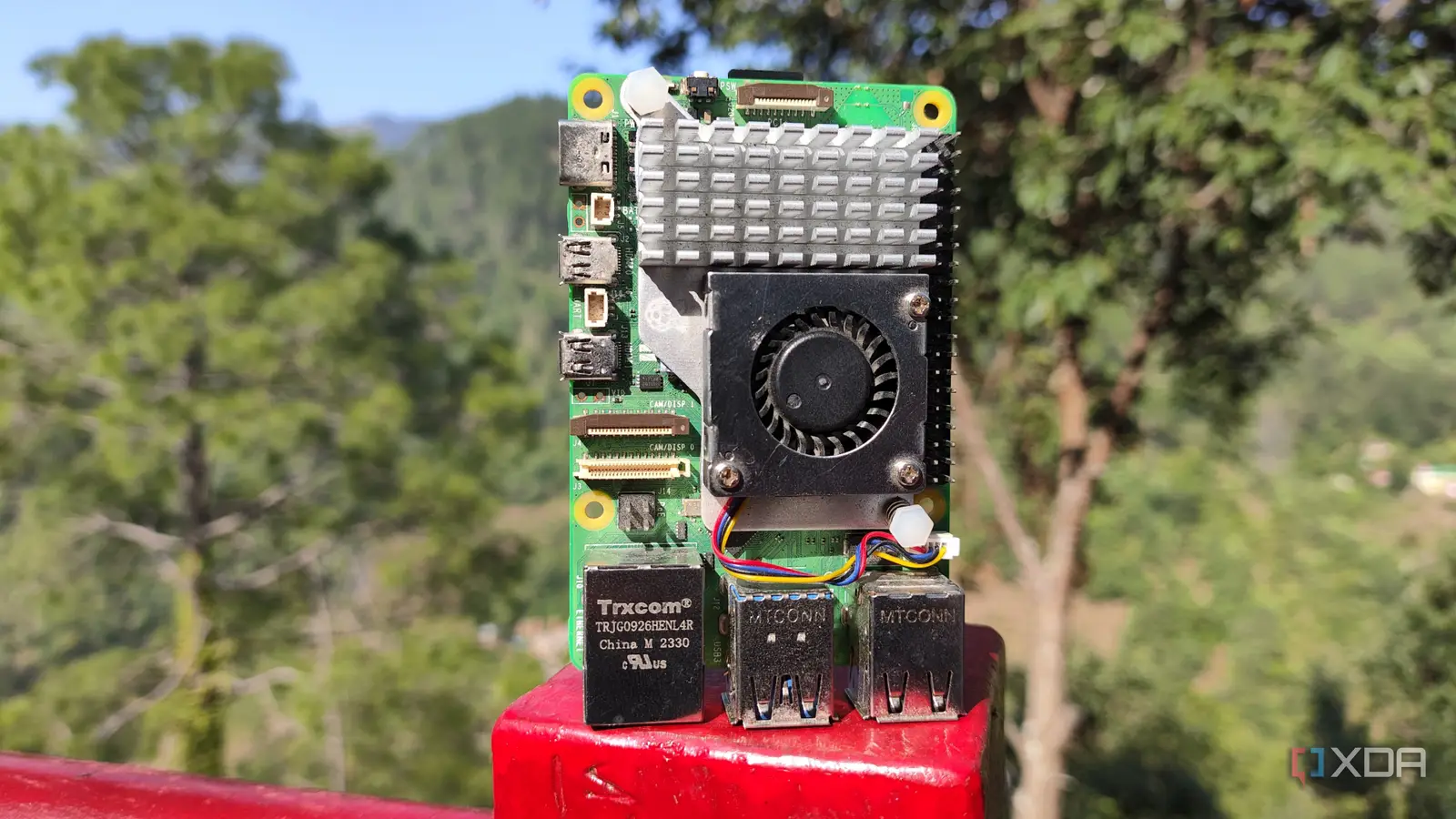
The Raspberry Pi 5 represents a significant leap forward compared to previous models, featuring faster CPUs, more capable GPUs, and support for PCIe devices that unlock a new world of possibilities. While you can certainly use it for the same lightweight projects you might have run on a Pi 4, that would be underselling its potential. The Pi 5 shines brightest when you throw heavier workloads at it, the kind that would have brought older Pis to their knees. These projects show off just how much muscle the Pi 5 has and why it’s no longer just a hobbyist’s toy.
High-end retro gaming and emulation
Why the Pi 5 finally makes demanding systems playable
Retro emulation has always been a favorite use case for Raspberry Pi owners, but there were clear limits on what earlier models could handle. The Pi 4 could manage 16-bit consoles and some PlayStation 1 titles, but struggled badly with Nintendo 64, PlayStation 2, and Dreamcast emulation. With the Pi 5, the bump in processing power and graphics capability makes those systems much more feasible, often at full speed with proper configuration. That means you can finally revisit some of your favorite classics without stutters and frame drops.
The upgraded GPU in the Pi 5 is key to this improvement, as it’s far better equipped to deal with the 3D rendering demands of newer retro systems. Games that once looked like slideshow presentations on the Pi 4 now run with smooth animations and consistent frame rates. Pairing the Pi 5 with optimized emulation software, such as Batocera or RetroPie, takes things even further, unlocking access to a vast library of retro systems that feel much closer to their original hardware counterparts.
Another benefit is how well the Pi 5 handles multiple emulation tasks. You can set up a polished front end, complete with box art, video previews, and a custom interface, without bogging down performance. Combined with support for Bluetooth controllers and HDMI output, the Pi 5 delivers a console-like experience that rivals purpose-built retro gaming systems. For anyone who has long dreamed of portable or living room emulation setups, the Pi 5 finally delivers on that promise.
Running lightweight AI and machine learning models
How local inference demonstrates the Pi 5’s raw power
Artificial intelligence projects were once completely out of reach on a Raspberry Pi, but the Pi 5 changes that equation. With its more powerful processor and PCIe expansion capabilities, it can handle smaller machine learning models locally. While it won’t replace a dedicated GPU workstation, it’s more than capable of running models for object detection, speech recognition, or basic natural language processing. That’s a huge step forward for developers who want to prototype AI ideas on inexpensive hardware.
By combining the Pi 5 with hardware accelerators like Google Coral’s Edge TPU, you can push performance even further. This pairing makes it possible to run computer vision projects that can recognize objects in real-time, making the Pi 5 a practical choice for robotics or home automation with intelligent detection capabilities. The fact that the Pi 5 can support these workloads means it’s no longer relegated to lightweight scripting or simple IoT duties. It opens the door for experimentation with real-world AI use cases.
Running AI locally also highlights the Pi 5’s ability to handle multitasking. While inference models are working, you can still manage monitoring dashboards, data storage, and even lightweight visualization without grinding the system to a halt. That makes the Pi 5 a legitimate edge device for AI projects, ideal for learning, tinkering, or even deploying small-scale intelligent systems. It’s an entirely new class of project that older Raspberry Pis just weren’t suited for.
True desktop replacement performance
Pushing the Pi 5 as a daily driver computer
Using a Raspberry Pi as a desktop or laptop replacement has always been more of an idea than a reality. The Pi 4 got closer with its USB 3.0 ports and dual 4K display support, but it was still slow and limited once you tried to use it for real productivity. The Pi 5 takes this concept much more seriously, offering a faster CPU and GPU combination that makes basic desktop computing feel smooth and responsive. For tasks like web browsing, word processing, and even light coding, the Pi 5 can keep up.
What really makes the Pi 5 stand out as a desktop replacement is its ability to handle multitasking exceptionally well. Switching between tabs in Chromium, editing documents, and streaming media no longer feels like pushing the hardware to its limits. Instead, the system has headroom, allowing you to run productivity apps and background processes simultaneously. This makes the Pi 5 a solid option for budget-friendly computing or secondary workstations where cost and efficiency are most important.
Of course, the Pi 5 isn’t going to outperform a high-end laptop or desktop PC, but that’s not the point. The real story here is how much closer it brings Raspberry Pi hardware to feeling like a traditional computer. It can serve as a low-cost system for students, hobbyists, or anyone who needs a simple machine that still supports a modern Linux desktop environment. The Pi 5’s leap forward in everyday usability shows just how far the platform has come.
High-speed networked storage solutions
Leveraging PCIe and faster I/O for serious NAS builds
One of the most impressive new features of the Pi 5 is its support for PCIe devices, which significantly enhances the capabilities of storage-focused projects. On older Pis, USB-attached storage was the only realistic option, and performance often fell far short of what serious NAS builders wanted. With the Pi 5, you can utilize NVMe SSDs via PCIe adapters, unlocking speeds that make it a viable real-world network storage solution. This transforms the Pi 5 into a compact yet powerful home server for managing data.
Performance isn’t just about raw transfer speeds, though. The Pi 5’s faster I/O also makes it more capable of handling multiple users accessing files simultaneously. That means you can realistically run it as a family file server, a media storage hub, or even as part of a small home lab without hitting bottlenecks. For anyone used to the sluggishness of older Pi-based NAS setups, the difference is night and day.
This performance boost also enables advanced storage features, such as RAID arrays, automated backups, and experimenting with ZFS on ARM hardware. While you’d still want a more powerful system for enterprise use, the Pi 5 now crosses into territory where it can serve as a dependable storage solution for home or small office environments. It’s a prime example of how the new hardware elevates the kinds of projects that are possible.
4K media center with advanced features
Smooth playback, HDR, and multitasking on the Pi 5
Media centers have always been a typical Raspberry Pi project, but they’ve often required compromises. The Pi 4 could output 4K, but performance was inconsistent, and high-bitrate files frequently stuttered or dropped frames. With the Pi 5, 4K playback is smooth, and features like HDR support make it far more future-proof. Running software like Kodi or Plex on the Pi 5 finally feels seamless, even with demanding video streams.
The one caveat is that, unlike the Raspberry Pi 4, the Pi 5’s GPU does not support hardware encoding. Raspberry Pi engineers prioritized HEVC (H.265) decoding and cost savings with this design; however, the tradeoff leaves the Pi 5 less suited for NVRs and other applications that rely on hardware-accelerated H.264 encoding.
The lack of hardware encoding means users may encounter:
Higher CPU usage: Without hardware encoding, the Pi 5’s CPU works harder during video encoding, which can reduce performance for other tasks.
Weaker H.264 and H.265 support: Software encoding can handle some workloads, but high-resolution or multiple H.265 streams will push the CPU beyond its limits.
Reduced compatibility with certain devices: Many budget IP cameras and other hardware that rely on H.264 encoding won’t pair well with the Pi 5.
Poor fit for surveillance workloads: NVRs and similar applications that need to process many H.264 streams perform poorly without hardware encoding support.
Shifted CPU priorities: The Pi 5’s CPU can now handle more decoding tasks than before, but this comes at the expense of encoding performance.
One of the standout aspects of using the Pi 5 as a media center is its ability to multitask while handling playback. You can stream media to multiple devices, keep track of your library, and even run add-ons or extensions without bogging down the system. The faster processor and GPU mean you no longer have to choose between smooth playback and extra features. This makes it an excellent fit for living rooms where people want both reliability and flexibility.
With support for modern codecs and hardware decoding, the Pi 5 also positions itself as a more efficient alternative to budget streaming boxes. You’re not just limited to media playback either—you can integrate the Pi 5 into a larger smart home setup, tying it into automation or voice control systems. The combination of raw performance and flexibility makes it one of the best all-around media solutions in this price range.
These projects reveal the Pi 5’s true potential
The Raspberry Pi 5 is more than just a modest upgrade over its predecessors. These projects show that it can now handle tasks once considered impossible for such a small and affordable board. From retro emulation and AI to storage and media, the Pi 5 is finally powerful enough to push into categories usually reserved for full PCs. If you’ve been waiting for a Raspberry Pi that truly stretches its hardware limits, this is the one to build with.



